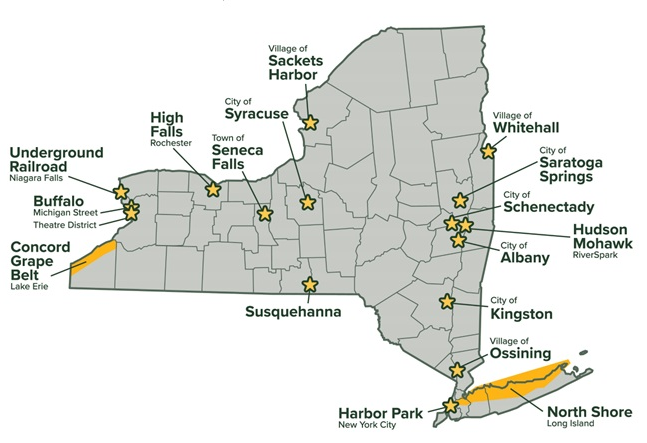Heritage Areas
New York State’s Heritage Areas are designated by the State Legislature under section 35.03 of the Parks, Recreation and Historic Preservation Law. Following designation, a Heritage Area Management Plan is developed and presented to the Commissioner of Parks, Recreation and Historic Preservation for approval. Active Heritage Areas with approved Management Plans are eligible to apply for EPF funding under OPRHP’s Environmental Protection Fund Grants for Parks, Preservation and Heritage.
The Heritage Area program under the Environmental Protection Fund Grant Program for Parks, Preservation and Heritage (EPF) is for projects to acquire, preserve, rehabilitate or restore lands, waters or structures, identified in the approved management plans for Heritage Areas designated under section 35.03 of the Parks, Recreation and Historic Preservation Law and for structural assessments or planning for such projects.
Applicants for Heritage Area funding must submit a letter of approval and endorsement from the local Heritage Area‘s management entity. The letter should reference the appropriate Heritage Area management plan and relevant Heritage Area resources and goals. To request an endorsement letter, or see a copy of the Management Plan, contact the Heritage Area, as listed below.
HERITAGE AREA CONTACTS
| Management Entity/ | Contact Person | |
|---|---|---|
| Management Contractor (if any) | Title | Phone number |
| CAPITAL DISTRICT REGIONAL ECONOMIC DEVELOPMENT COUNCIL REGION: | ||
| ALBANY | ||
| City of Albany / Discover Albany | Maeve McEneny-Johnson | mmceneny@albany.org |
| Director of Community Engagement | (518) 434-1473 | |
| HUDSON MOHAWK—RiverSpark | ||
| Hudson-Mohawk Urban Cultural | Ed Tremblay | EdTremblay54@gmail.com |
| Park Commission / Hudson-Mohawk | (518) 764-5494 | |
| Industrial Gateway | ||
| SARATOGA SPRINGS | ||
| City of Saratoga Springs | Michael Dutre | Michael.Dutre@saratoga-springs.org |
| Administrator of Parks, Open Lands and Historic Preservation |
||
| SCHENECTADY | ||
| City of Schenectady | Alexandria Carver | acarver@schenectadyny.gov |
| Director of Development | (518) 382-5149 | |
| WHITEHALL | ||
| Village of Whitehall | Philip Smith | villagemayor@whitehallny.org |
| Mayor | (518) 499-0871 | |
| CENTRAL NEW YORK REGIONAL ECONOMIC DEVELOPMENT COUNCIL REGION: | ||
| SYRACUSE | ||
| City of Syracuse | Janet Burke | JBurke@syr.gov |
| Bureau of Research | (315) 448-8061 | |
| FINGER LAKES REGIONAL ECONOMIC DEVELOPMENT COUNCIL REGION: | ||
| ROCHESTER—High Falls | ||
| City of Rochester | Kabutey Ocansey | Kabutey.Ocansey@cityofrochester.gov |
| Commissioner, Dept. of Environmental Services |
(585) 428-6855 | |
| SENECA FALLS | ||
| Town of Seneca Falls/ | Andrew Olden | director@senecamuseum.com |
| Seneca Museum of Waterways | Executive Director,Seneca Falls | (315) 568-1510 |
| and Industry | Museum & Tourism Center | |
| LONG ISLAND REGIONAL ECONOMIC DEVELOPMENT COUNCIL REGION: | ||
| LONG ISLAND NORTH SHORE | ||
| Long Island North Shore Heritage | John E. Coraor, Ph.D. | jcoraor@gmail.com |
| Area, Inc. | President | (631) 271-3909 |
| MID-HUDSON REGIONAL ECONOMIC DEVELOPMENT COUNCIL REGION: | ||
| KINGSTON | ||
| City of Kingston | Suzanne Cahill | scahill@kingston-ny.gov |
| Planning Director | (845) 334-3955 | |
| OSSINING | ||
| Village of Ossining | Bill Garrison, Superintendent | wgarrison@villageofossining.org |
| of Recreation & Parks | (914) 432-8330 | |
| MOHAWK VALLEY REGIONAL ECONOMIC DEVELOPMENT COUNCIL REGION: | ||
| NEW YORK CITY REGIONAL ECONOMIC DEVELOPMENT COUNCIL REGION: | ||
| NEW YORK CITY—Harbor Park | ||
| City of New York/ | Warrie Price | wprice@thebattery.org |
| The Battery Conservancy | Director of Harbor Park | (917) 409-3711 |
| (917) 224-5400 (cell) | ||
| NORTH COUNTRY REGIONAL ECONOMIC DEVELOPMENT COUNCIL REGION: | ||
| SACKETS HARBOR | ||
| Village of Sackets Harbor | David Altieri | heritage.director@sacketsharbor-ny.gov |
| Heritage Area Coordinator | (315) 489-3642 | |
| Janet Quinn | jquinn733@gmail.com | |
| Heritage Area Member | ||
| SOUTHERN TIER REGIONAL ECONOMIC DEVELOPMENT COUNCIL REGION: | ||
| SUSQUEHANNA | for Broome County: | |
| Susquehanna Heritage Area Commission | Lora Zier | Lora.Zier@broomecountyny.gov |
| Senior Planner, Broome County | (607) 778-2114 | |
| for Tioga County: | ||
| Rebecca Maffei | rebecca@experiencetioga.com | |
| Director, Tioga County Tourism | (607) 687-7440 | |
| WESTERN NEW YORK REGIONAL ECONOMIC DEVELOPMENT COUNCIL REGION: | ||
| BUFFALO—Michigan Street African American Heritage Corridor | ||
| Michigan Street African American | Terry Alford | talford@michiganstreetbuffalo.org |
| Heritage Corridor Commission, Inc. | Executive Director | (716) 332-1002 |
| Kalista Cozza | kcozza@michiganstreetbuffalo.org | |
| BUFFALO—Theatre District | ||
| City of Buffalo | Michael Godfrey, ACIP | mgodfrey@buffalony.gov |
| Deputy Director of Planning & Zoning, | (716) 851-4707 | |
| Office of Strategic Planning | ||
| LAKE ERIE CONCORD GRAPE BELT | ||
| Concord Grape Belt Heritage | Philip Baidem | pbaideme@roadrunner.com |
| Association | pgb.osu71@gmail.com | |
| manager@grapediscoverycenter.com | ||
| NIAGARA FALLS UNDERGROUND RAILROAD | ||
| Niagara Falls Underground Railroad | Ally Spongr DeGon | ally@niagarafallsundergroundrailroad.org |
| Heritage Area Commission, Inc. | Director | (716) 300-8477 |

For exact Heritage Area boundaries, click on the map links below or use the Grants Map for CFA.
